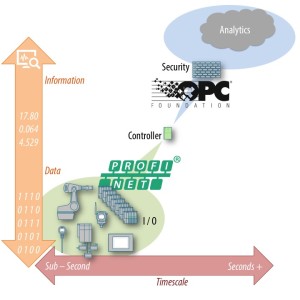Standards and Protocols for the IIoT:
A look at how open data access protocols like Profinet can be used to provide data for Internet of Things deployments.
The technologies behind the Industrial Internet of Things (IIoT) have existed for many years. Consider these three terms often used in IIoT discussions:
- Remote access … That’s old news.
- Machine-to-machine … Been there, done that.
- Cloud … Really just another name for off-site server.
These technologies have long existed mostly as proprietary solutions and have worked well for many users. What’s changing is that the Industrial Internet of Things (IIoT) concept is driving the automation industry to ensure greater interoperability of its products. And that means it’s time to find standards to apply to these technologies and their applications.
Where standards exist, innovation is driven; disruptive technologies emerge; and things become cheaper, smarter, and easier to use. Standard protocols will allow even the smallest manufacturer to see benefits from the IIoT. The key point to understanding how this will happen is to realize the IIoT movement is not about the “things” themselves; it’s about the data.
A great example of this can be seen in what’s happening with fieldbus networks. These legacy networks are fast, efficient, reliable, incredibly robust, and widely adopted. However, there is a growing trend in the marketplace to migrate away from fieldbuses and toward industrial Ethernet. The reason behind this move is clear: data access.
Industrial Internet vs. Industrial Ethernet
If industrial Internet is the “what”, then Industrial Ethernet is the “how”. As more complex devices are brought to market, two factors remain unchanged:
- The need for deterministic control; and
- The desire for increased data access.
Modern advanced manufacturing has already begun leveraging the global proliferation of Ethernet (which happens to be a standardized protocol) to bring its richness down to the field level. With industrial Ethernet becoming more established across industry, the industrial Ethernet can be leveraged to enable the industrial Internet.
To understand how this can be done, look at the timescales on which these two operate. Industrial Ethernet (e.g., Profinet) is concerned with sub-second timeframes. Stepping back from the sub-second timeframe (to a longer time frame), industrial Ethernet becomes industrial Internet. This transformation happens as the granular sub-second data develops into information when viewed/analyzed over a longer time frame.
Information Starts as Data
Without access to operational data, there is no IIoT. Assuming you are looking to access the data from your industrial Ethernet network, what are you going to do with it?
For starters, buffer it. Those little bits and bytes zipping around devices at the field level do little to inform business decisions on their own. But those pieces of data can be monitored (using remote access), gathered (in a historian), stored (in the cloud), and otherwise examined using Big Data or business intelligence systems. Collectively, all that sub-second data becomes information that can be used to drive decision making.
Profinet and IIoT
 Nearly every week we are asked: How does Profinet fit in the Industrial Internet of Things. The key word in this question is “fit”. An industrial Ethernet protocol like Profinet is just one piece of the pie. Its main concerns are deterministic control, data access, and maximizing production uptime.
Nearly every week we are asked: How does Profinet fit in the Industrial Internet of Things. The key word in this question is “fit”. An industrial Ethernet protocol like Profinet is just one piece of the pie. Its main concerns are deterministic control, data access, and maximizing production uptime.
It is also an open network, which means that other applications (e.g., HTTP, SNMP, ARP, TCP/IP, etc.) can seamlessly run on the same wire as Profinet. Because the protocol ensures real-time data exchange, customers can use whatever application they see fit. But the fact remains that other protocols will likely be required to bring the information to systems at the enterprise level.
For example, OPC UA is a standard protocol for moving information. One can easily envision a system where the Profinet protocol is employed for control and data access and protocols like OPC UA are employed for information.
No matter which direction the Industrial Internet of Things is headed, standard open protocols will help spur the innovation behind it.
